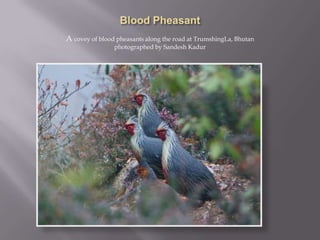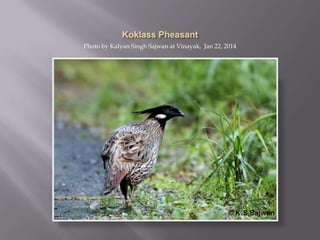Winged guardians of mountainscapes
- 3. Pheasants belong to the order Galliformes or fowl like birds. This large family of birds includes the jungle fowl and peafowl which are found in the plains of India. The focus of this presentation is “mountain pheasants” which originated in the young Himalayan Mountains. Almost all pheasant species are exploited in their native habitat by local communities and visiting hunters. Sixteen species have been introduced outside of their natural ranges for ornamental purposes, hunting, eggs and meat collection or for feathers . Over one-third of total species of pheasants are officially listed as in danger of extinction from their native Habitat.
- 6. Pheasant species range from sea level to 4,200 m mountain pheasants which inhabit the Himalayas and the higher mountain ranges of China, Japan, and Taiwan, and low elevation species like peafowl and jungle fowl. Since pheasants are ground dwelling birds, they are particularly vulnerable to human disturbance. After establishing a close link between oak trees and pheasants for shelter, ecologists have reached the conclusion that a decline in the pheasant population mirrors an adverse change in the mature forest. So in scientific terms, pheasants are considered „indicator species„ of healthy habitat
- 7. Photo by Amit Rane Kedarnath Wildlife Sanctuary, October 2013
- 8. Photo by Maitreyee Das Neora Valley National Park near Lava in Darjeeling District 26th April, 2009.
- 9. A covey of blood pheasants along the road at TrumshingLa, Bhutan photographed by Sandesh Kadur
- 10. Photo by Gaurav Deshmukh Near Gopeshwar, Uttarakhand - Jan 2014
- 11. Photo by Kalyan Singh Sajwan at Vinayak, Jan 22, 2014
- 12. Photo by Garima Bhatia from Vinayak (near Pangot) taken 10th April 2011
- 13. Painting by Ragoo Rao These birds have not been seen in the wild since 138 years
- 14. The pheasants are more than just beautiful birds, for they also have scientific value for environmentalists and ecologists. Years of research have shown that Himalayan pheasants are mostly found in moist, temperate forests where there is a thriving community of oak trees. Oaks are important in ecological terms because they grow only in forests that are mature with plenty of healthy undergrowth in the form of vibrant grasses and bushes and a wide array of specialized tree species.
- 15. In scientific terms, pheasants are considered “indicator Species” of a habitat. An indicator species is an organism whose presence, absence or abundance reflects a specific environmental condition. Anyone living in the mountains will vouch for the Himalayan Monal whose calls warn the ground dwelling animals like musk deer, tahr and bear of approaching hunters /poachers. A healthy population of pheasants means a mature forest.
- 16. Habitat Loss and Habitat degradation Herbicides and Fertilizers used in agriculture Hunting Damaging of nests by dogs , fire, forest produce collectors The hills and valleys of the Himalayan ranges are the only areas left in the world where these exotic birds species still exist in their natural surroundings. Future of these birds is bleak unless awareness about their role in protecting the mountainscape is brought to the locals in their language.
- 17. Create awareness among the people who live with pheasants in the mountains Awareness leads to conservation. Example; Community Conservation areas in Nagaland, Meghalaya protecting Amur Falcon, Hornbill. A comprehensive program of conservation education should be started for schools and children of the local communities Natures own protection for our young Himalayan mountains is the hardy bushes keeping soil erosion at bay. These very bushes and lichen are the key to conserving pheasants.
- 18. Current knowledge on the ecology, social behavior, and biology of pheasants is thanks to research projects by NGOs like World Pheasant Association(WPA) India chapter WWF -India Aranyak, Assam SACON(Salim Ali Centre for Ornithology and Natural History) ATREE(Ashoka Trust for Research in Ecology and the Environment) FES(Foundation for Ecological Security)
- 19. In the next few slides we examine the degradation and loss of pheasant habitat in a run up to the Uttarakhand Floods of June 2013..
- 20. Replacement of Himalayan oak on the higher slopes by the commercially more viable pine is weakening the slopes. Oak leaves help to create a thick undergrowth that absorbs rainwater whereas pine needles make a smooth dry carpet that does not absorb water and even prevents undergrowth. (article in HT)
- 21. Vegetative cover slows the speed of falling rain and prevents soil erosion and gully formation — the precursors to landslides and floods.
- 22. In the Himalayan region, the soil formation is a comparatively rapid process, the damp, evergreen forests playing an important part in the generation and conservation of the soil cap. Given that the Himalayan range is geologically young and still rising, it makes the area vulnerable to erosion and instability.
- 23. Dense vegetation, by evapo-transpiration, also stops nearly 30-40 per cent of rainwater from falling to the ground, thereby significantly reducing run-off. Besides holding the soil together, forests and soil soak water from the rain, release it slowly and prevent water flowing as run-off.
- 24. Degradation of mountainscapes – Photo(2009) Proposed Auli artificial ski slope
- 25. Musk Deer, Himalayan Thar, Serow and Pheasants make the Himalayan Region an area of immense national significance. But the winged guardians of these mountainscapes are indeed the pheasants.
- 26. After the flash floods of 16th June, 2013, causing unimaginable loss to lives and property, it is time to rebuild. (Photo Mousree Ganguli, 14th June 2013 )
- 27. The spectacular Monal, state bird of Uttarakhand is worth protecting; because protecting its habitat means protecting all other pheasants and galliformes, the musk deer, tahr, serow, bear ....the ecosystem which prevents natures fury overtaking us, humanity.
- 28. Beginning a dialogue on pheasants -their role in protecting our mountains, their role as apex species warning others of danger. This is the goal of my presentation. In Europe only the Alpine Chough survives in high altitudes. (Photo Schilthorn, Swiss Alps) Our high altitudes are still blessed with wildlife and the gorgeous pheasants. Let us protect them and protect ourselves .
- 29. Click inside the box to watch a short clip on mountain pheasants
Editor's Notes
- Thanks for raising the issue of Asian Pheasants...The view of these species as Game Birds in Europe and the US was propagated by the import and rearing for sport a number of Asian Pheasants/Partridges and Quail...Also, here in China and in other Asian countries, birds are indeed hunted for food..there's a lot of meat on a Monal.. These birds are Asia, they represent the beauty and wildness that is being dreadfully eroded by the insane population and industrial expansion. –Alister BennThe Kedarnath Wildlife Sanctuary appears to be a truly beautiful place and these pheasants are obviously very special birds. –Jerry Merrel
- A covey of blood pheasants along the road at TrumshingLa, Bhutan photographed by SandeshKadur
- Most Common and widespread
- Belonging to the pheasant family, the Himalayan Quail (Ophrysiasuperciliosa), is a medium-sized quail. It is one of the rarest birds in the world and is listed in the Schedule I of the Wildlife (Protection) Act, 1972 of India and categorized as Critically Endangered in the IUCN Red List. Some sources believe the quail to be extinct as its last confirmed sighting was way back in 1876. Due to a spate of recent sighting reports, although all of which are unconfirmed, there is hope that an invisible population of the bird may still be alive.
- River otters have been used as indicators of healthy, clean river systems.
- Lichens: some species indicate low air pollutionLichens as a group have a worldwide distribution and grow almost on any surface, for example soil, bark, roof tiles or stone. Because lichens get all their nutrients from the air, many species are very sensitive to air pollution.Lichens are organisms comprising both fungi and algae. (They are not plants.) Lichens are found on rocks and tree trunks, and they respond to environmental changes in forests, including changes in forest structure – conservation biology, air quality, and climate. The disappearance of lichens in a forest may indicate environmental stresses, such as high levels of sulfur dioxide, sulfur-based pollutants, and nitrogen oxides.
- In the Himalayan region, the soil formation is a comparatively rapid process, the damp, evergreen forests playing an important part in the generation and conservation of the soil cap.
- Dense vegetation, by evapo-transpiration, also stops nearly 30-40 per cent of rainwater from falling to the ground, thereby significantly reducing run-off. Besides holding the soil together, forests and soil soak water from the rain, release it slowly and prevent water flowing as run-off
- photo of the Camp was taken by Mousree Ganguli just two days before the floods ravaged it, in June 2013.






























